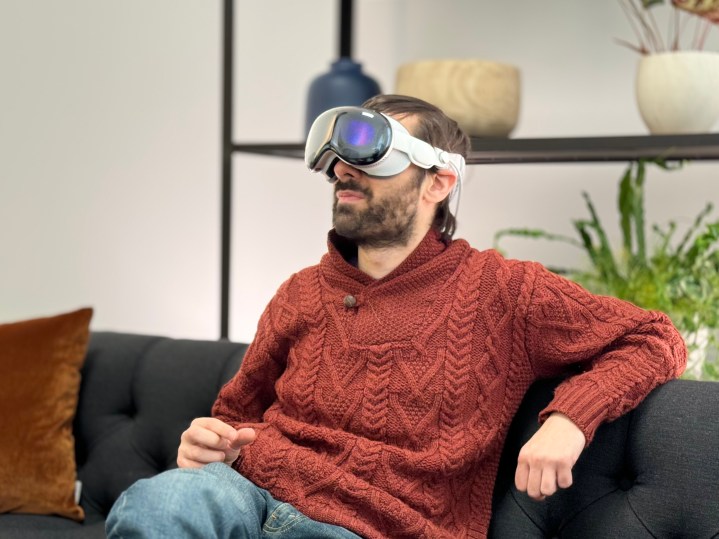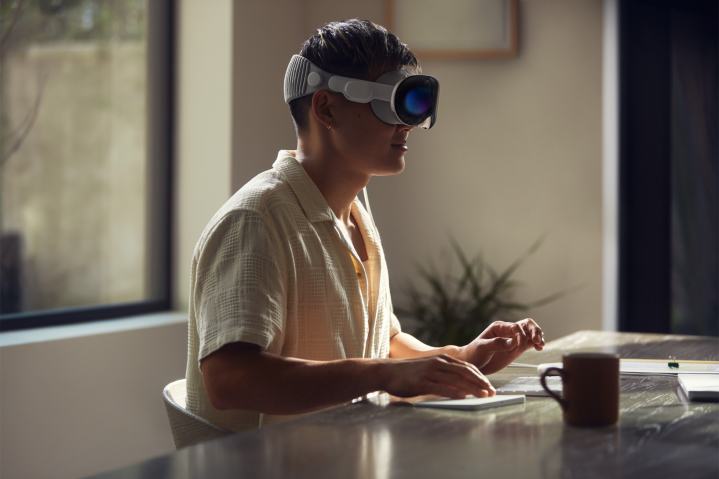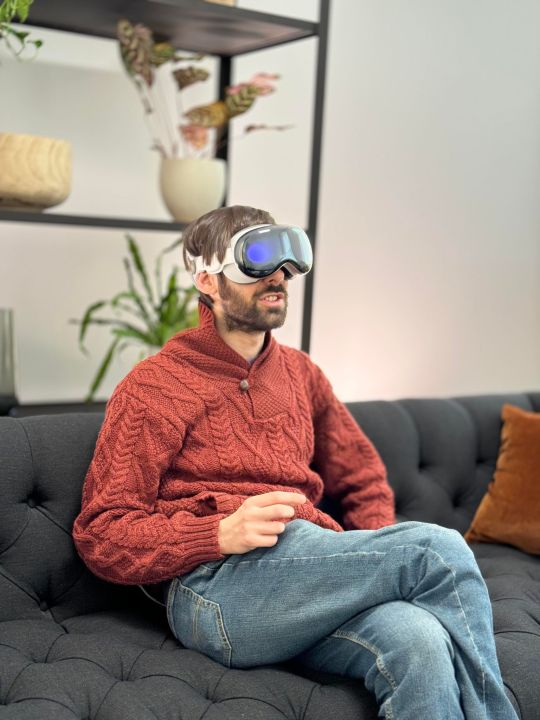
One week ago, if you had asked me if I planned on getting an Apple Vision Pro, I would have scoffed. Why try typing on a clumsy digital keyboard when I could work much faster on a real one? Why watch a movie on a flat screen inside a headset when I could just turn on my TV? Wildly expensive, superfluous tech is just not for me.
But after one half-hour session with the Vision Pro, I might be a changed man. Maybe it’s just the stunning resolution talking, but I can more easily see a future where the tech enhances some aspects of my life. The only thing I’m still not sold on? Actually wearing the thing.
Learning the ropes
In my hands-on session, Apple would guide me through several impressive experiences across a handful of apps. First thing was first, though: I’d need to learn how to use it. Compared to VR headsets I use regularly, the Vision Pro is much easier to put on and get running. I’d pull it over my head, turn a dial to tighten its knit headband, and look at a few dots to set up eye-tracking in the span of a few short minutes. With that sparse setup out of the way, I was tossed right into an app selection screen with nothing but my eyes and hands to control my experience from there.
What immediately stands out is how quickly I was able to navigate menus with barely a moment of tutorial. All I had to do was stare at an app icon, and the headset would highlight it exactly as I had expected. Clicking on it was a simple matter of pinching my fingers. While I wondered how accurate that would be, the Vision Pro barely missed a single gesture, whether my hand was resting on my lap or raised closer to my chest.
The only learning curve came from holding back my fidgety tendencies. Early in the demo, I had a few clumsy interactions from subconsciously mirroring gestures with my other hand or moving my free fingers around. That led to a few hiccups where I’d zoom in on a picture instead of clicking a button. I quickly cut out those bad habits, though it took a few minutes of sitting on my left hand to keep it out of the camera’s view.
My experiences built up in complexity through the half hour. I started by simply scrolling through a photo album. I was immediately struck by how intuitive that experience was. I could grab the bottom right corner of a photo to expand it, pinch with two fingers to zoom in, move my fingers up to scroll, or move the app around by grabbing a white bar at the bottom of the app. I barely had to think about what I was doing; every gesture came naturally.
Using a pricey headset to look at photos is certainly wasteful, but Apple made a much stronger case for the Vision Pro as the demo went on. I first saw that when I opened a panoramic photo that stretched across my field of vision. Panoramas have never made much sense to me on devices like the iPhone, but it feels like they were built for the Vision Pro all along. Those long photos become immersive landscapes in the headset.
What’s significantly more impressive is the headset’s spatial image tech. I opened up a folder full of images and videos captured on the device, mostly family photos. Those images look almost fully 3D, with way more depth than in a flat photo. It’s so uncanny that it’s almost creepy at first. I was even more blown away when I was shown a few videos, complete with spatial audio. One shows a mother blowing bubbles with her child, the bubbles in the foreground almost popping out of the screen. It’s hard to describe (and perhaps playing exactly into Apple’s ideal marketing playbook), but it actually feels like I’m viewing a memory. It’s like living in a piece of sci-fi pulled straight from Blade Runner.
It’s important to note that all of this is only possible because of the Vision Pro’s miraculous display. The micro-OLED display is superior to anything I’ve seen in a headset yet, providing crystal clear visuals. I didn’t even have to fiddle with it to get a clean image; I strapped it on, and the headset took care of the rest after automatically calibrating the eyecups. The headset’s tight fit also significantly cuts down on outside light – I only noticed a very slight leak in the bottom left corner. All of that cuts out any of the technical friction that comes with other headsets that require immersion-breaking fiddling.
More experiences
Now fully acquainted with the headset, I worked my way through a small list of apps with varying degrees of success. I’ll get the low point out of the way first: The Vision Pro isn’t the most intuitive desktop computer. When opening up the Safari browser, I’d click the browser search bar to open a virtual keyboard in front of me. This was the most imprecise part of the demo, as I had to slowly and carefully pluck keys one at a time to write out a website. My taps didn’t always register as expected. When I realized I’d made a typo in my URL, I struggled to single out the wrong letter and backspace it. The UI is simply too small to control with my clumsy fingers (though its microphone would very clearly hear me register my request to write out “Apple dot com”).
The more traditional the experience, the less practical it was. It’s simply more efficient to surf the web or write a document with a mouse and keyboard. While “spatial computing” is the hot term for what the Vision Pro can do, I don’t see many people engaging with the actual computing part of that. It’s like when your Xbox comes with a web browser; it has to be there, and it works when you need it, but that doesn’t mean you’ll ever want to use it.

The Vision Pro’s power squarely lies in apps built for the device. I’d see plenty of those in action. An experience titled Encounter Dinosaurs put me in an interactive museum exhibit where the wall in front of me opened up, and I got to interact with a dinosaur as it scampered around me. I’d drop a life-sized Alfa Romeo F1 car in the room using the JigSpace app and pluck off its parts with a pinch to examine them closely. I even found myself sitting in a 360-degree recreation of Avengers Tower through the Disney+ app, which I could turn into a personal movie theater. Each of those experiences showed the unique power of mixed reality, making great use of the headset’s shockingly clear passthrough video.
How clear? It’s like looking through a freshly cleaned window. I hardly noticed any unsightly grain, putting it leagues ahead of devices like the Meta Quest 3. Granted, I was testing it in a very brightly lit room surrounded by white walls. The real test will be whether or not the clarity holds up in your average living room. Everything I’m praising here was done in a tightly controlled environment; Digital Trends wasn’t even allowed to take our own photos of the device (an Apple photographer took the images in this article). Whether or not all of this will work as well outside of the perfect test scenario is yet to be seen.
Entertainment seems to be a big focus for Apple at launch and I saw some strong examples of that during my demo. Using the Apple TV app, I dropped into a virtual movie theater to watch a scene from The Super Mario Bros. Movie. Here, I got a full movie theater simulation where I could choose how close I was to the screen and whether I was viewing it from a floor or balcony. That may sound hokey, but it really did feel like sitting in a theater. Even more impressive, though, was when I watched a reel of 180-degree videos captured in 8K. One quick shot put me right above a soccer net during a game, allowing me to see the action up close.
That single shot convinces me that the Vision Pro could truly be the future; I feel like I’m actually in the moment. I can see a world where I could virtually attend something like Taylor Swift’s Eras Tour and have a blast exploring the stage from a few well-placed cameras on stage.
No pain, no gain
While all of this is impressive, there’s a key element that may torpedo the entire experiment for many: The Apple Vision Pro isn’t terribly comfortable to wear for a long period of time.
It’s not so much the weight that’s the problem, as some have speculated. As a regular VR user, it doesn’t feel that much heavier than my PlayStation VR2. The problem is more in the discomfort that comes with an electronic device squeezing your head. To Apple’s credit, the knit headband goes a long way toward making the experience more comfortable than most headsets. The problem more so lies in the front piece. I felt hard materials squeezing down on my temple the entire demo. When my 30 minutes were up, I was relieved to pull it off.

I hope that’s just the result of me being a novice. Perhaps I could get a more comfortable fit with some more practice. That feeling, however, matches what I’ve felt wearing headsets like Meta Quest 3. No matter how incredible the tech is, it is undeniably annoying to wear a giant helmet for a long period of time. The Vision Pro doesn’t solve that classic issue, which makes it feel like another stopgap device on the road to less intrusive mixed reality tech.
What turns me off even more is one of the Vision Pro’s most defining features: EyeSight. After my demo, Apple pulled me into a room where I got to see someone else wearing the device. Digital eyes appeared on the visor as we talked, replicating his movements and blinks. I’m no technophobe, but talking to someone while staring at their digitized eyes is downright creepy. Granted, it’s a functional feature too. A blue shimmer across the visor told me when the demoist had an app open and was no longer looking at me. That’s a handy tool in a world where offices adopt the tech, but I wouldn’t want to work at any place that required me to wear one.
Beyond comfort, any concerns I have with the Vision Pro are existential. As I lounged on a couch watching movies in the Vision Pro, I couldn’t help but think back to Wall-E, its oversized humans floating around a space station in headsets. Just because a device like Vision Pro can exist, does that mean it should? I can’t help but worry about what mass adoption would mean for humanity after having an entire conversation with a person and never seeing their real eyes.
Perhaps that’s a worry for another day, though. With its price point, there’s no universe in which every person will own a Vision Pro. Instead, it’ll be a niche tool for those who want to experiment with incredibly promising tech like spatial video. A lot of the apps I saw felt like convincing proofs of concept. The only question now is whether or not developers will drop thousands of dollars to start creating with it. A great guided demo is barely step one.
The Apple Vision Pro is now available to preorder.




